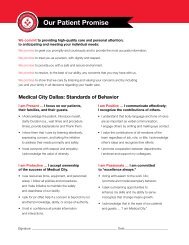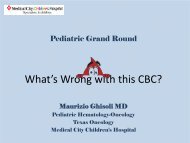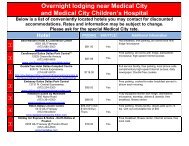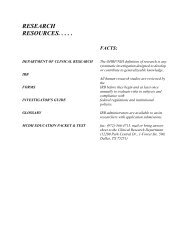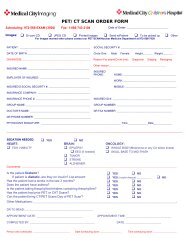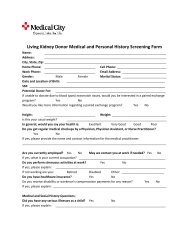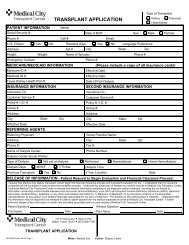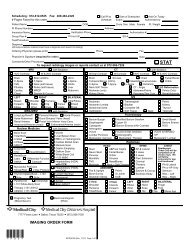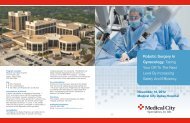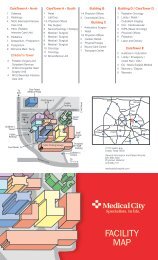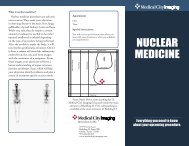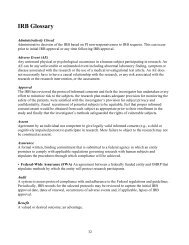UTIs: A better imaging strategy than the new AAP Guidelines
UTIs: A better imaging strategy than the new AAP Guidelines
UTIs: A better imaging strategy than the new AAP Guidelines
Create successful ePaper yourself
Turn your PDF publications into a flip-book with our unique Google optimized e-Paper software.
<strong>UTIs</strong>: A <strong>better</strong> <strong>imaging</strong> <strong>strategy</strong> <strong>than</strong><strong>the</strong> <strong>new</strong> <strong>AAP</strong> <strong>Guidelines</strong>Nicol Corbin Bush
Pathogenesis of VUR• VUR increases risk for pyelonephritis• Pyelonephritis results in renal scar• Renal scarring ↑ HTN, renal insufficiency
Traditional ManagementRefluxg I-IVDESAntibiotic prophylaxis (Deflux)No UTIUTIAnnual cystographySurgery (Deflux)ResolvedPersistsNoncompliantAntibiotic allergiesParent preference
Imaging and Therapy <strong>Guidelines</strong>• Renal US and VCUG after 1 st fUTI in children< 2yrs age<strong>AAP</strong> <strong>Guidelines</strong>, 1999• Universal VUR management based on likelihoodfor resolutionAUA <strong>Guidelines</strong>, 1997
ImagingProspective study 309 children 1-24 mRenal US, DMSA
2 Reasons to Diagnose, Treat VUR• Decrease recurrent febrile <strong>UTIs</strong>• Prevent additional renal scarring[no evidence tx effective]
What is risk for a 2 nd febrile UTI?‘No prophylaxis’ cohorts of RCTsmixed VUR + / - f/u 1 year 3-13%Garin et alPediatrics, 2006Montini et alPediatrics, 2009Craig et alNEJM, 2009all VUR + f/u 18-24 mos 16-37%Penessi et alPediatrics, 2008Roussey-Kesler et alJ Urol, 2008Brandstrom et alJ Urol, 2010
Does Antibiotic Px Work?• Antibiotic px confers little or no reduction inlikelihood for 2 nd febrile UTI in 1-2 yearsGarin et alPediatrics, 2006Roussey-Kessler et alJ Urol, 2008Penessi et alPediatrics, 2008Montini et al*Pediatrics, 2009Craig et al**NEJM, 2009* tx 42 children to prevent 1 UTI** tx 14 children to prevent 1 UTI
<strong>AAP</strong> Analysis:Pediatrics, 2011
Surgery: Evidence Based?• Significant reduction in febrile UTI in surgical vsantibiotic group (10% vs 22%)International Reflux StudyJ Urol, 1997• 10% febrile UTI after successful DefluxChi et alJ Urol, 2008
VUR and Renal Scar• No increased scars with VUR-Garin et al,Pediatrics, 2006-Doganis et alPediatrics, 2008• Scars increased with VUR-Hoberman et alNEJM, 2003-Polito et alPediatr Neph, 2009-Lee et alPediatr Neph, 2009
New AUA Reflux <strong>Guidelines</strong>Metaanalysis (4 reports): 2.5x increased riskfor scar with VURIndividualize <strong>the</strong>rapy according to perceivedriskNo treatment an option
Scar-based Management“late” DMSA≥ 3 mos after UTI• Pts with scars can develop <strong>new</strong> scars• Pts without scars may have less risk forscarring with future UTI
Consecutive Pts Referred 2008-2011
Prospective Observational Study• 106 males (19%)• 459 females (81%)565 consecutive patientsUTI and/or VUR• Average age 53.1 mo (SD 44.2), 21% < 1y• 84 (15%) focal scar on DMSA• 24 (4%) decreased function w/o scar
Focal DMSA Scarring by Grade of VUR95 (85%) 17 (15%) 112 (25%)137 (88%) 19 (12%) 156 (34%)111 (85%) 19 (15%) 130 (29%)27 (50%) 27 (50%) 54 (12%)Reflux increases renal scar risk 2.3xRisk for grade 1-3 same, vs increased with grade 4-5Most patients do not scar
Focal DMSA Scarring by Febrile UTI72 (89%) 9 (11%) 81 (15%)208 (92%) 18 (8%) 226 (43%)169 (76%) 53 (24%) 222 (42%)Most patients with recurrent febrile UTI do not scar(Not known when scarring occurred)
EffectTotalSubjectsN with abnormalDMSA OR Estimate 95% CIP-value(χ 2 )Age in Years 541 84 1.22 1.13-1.33
Additional Findings• Infants had less scarring 6% vs 18%, p=0.0016• Scar risk small, equivalent for VUR g I-III(“dilating” VUR is > g III)• Greatest risk factor is VUR g IV and V• Controlling for VUR, a single fUTI adds no riskSnodgrass, Bush,Revisions, JPediUrol 2012
Future Scar Risk if 1 st DMSA - ?• Cohort: 429 pts - DMSA scan after UTI• 5 <strong>new</strong> scars355 pts 2 nd DMSA 2-10 yrs later103 additional UTI4 in 53 patients > 3 <strong>UTIs</strong>Vernon et alBMJ, 1999
DMSA-Based Risk• More <strong>the</strong>rapy for DMSA + patients• Less (no) <strong>the</strong>rapy for DMSA - patients
Case 1• Case 1: 21 mo female, hx 1 fUTI age 17 mo
R 6.8cm, L 6.2cm, no hydronephrosis
Evidence-Based Decision Making• Case 1: 21 mo female, hx 1 fUTI age 17 morenal sono -DMSA: 37% R, multifocal scarsg3 R VUR‘Best option’: deflux or surgery to reduce UTI/scar risk• Case 2: 3 yr female, hx 3 fUTI in 2yrs-last UTI 1 year ago
R 7.5cm, L 7.8cm, no hydronephrosis
Evidence-Based Decision Making• Case 1: 21 mo female, hx 1 fUTI age 17 morenal sono -DMSA: 37% R, multifocal scarsg3 R VUR‘Best option’: deflux or surgery to reduce UTI/scar risk• Case 2: 3 yr female, hx 3 fUTI in 2yrsrenal sono - g3 R VURDMSA –‘Best option’: Does she need <strong>the</strong>rapy? Address DES
New <strong>AAP</strong> <strong>Guidelines</strong>• Dx: ≥50k organism + pyuria– “ill”: cath or suprapubic specimen– Not so ill, +suspicion (>39◦, no o<strong>the</strong>r source):1. Bag for UA, if +, <strong>the</strong>n cath• false + LE common; if – LE, only 6% chance of UTI2. Cath/suprapubic• ≥7 days Rx, IV = PO• After UTI dx: prompt eval (
New <strong>AAP</strong> <strong>Guidelines</strong>• Renal/bladder US– Abnormal ~15%, 1-2% ‘actionable’– False + rate 2-3%• VCUG for HN, dilated ureter, 2 nd UTI
New <strong>AAP</strong> <strong>Guidelines</strong>?• Renal ultrasound for 1 st fUTIVCUG for HN, dilated ureter, 2 nd UTI• Will miss 8% of pts < 24 m with decreasedrenal function and /or renal scar• Will miss 25% of pts > 24m
New“Top Down” Imaging1 st febrile UTIRUS + DMSA50% + DMSAall VCUG50% - DMSAno VCUG(6 mos DMSA scan)scar25% + DMSA 25% - DMSA all - DMSAVCUG
DMSA Risk-stratification• VUR increases febrile UTI, renal scarring• “Scar-based” assessment may identify pts mostlikely to benefit from <strong>the</strong>rapy• Promote reflux resolution (surgery or deflux) inthose with renal damage• Decrease interventions in those without renal scar



